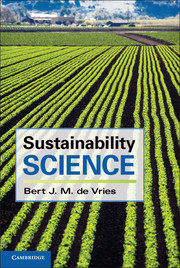Book contents
- Frontmatter
- Contents
- Preface
- 1 Introduction
- 2 The System Dynamics Perspective
- 3 In Search of Sustainability: Past Civilisations
- 4 The World in the Past 300 Years: The Great Acceleration
- 5 Sustainability: Concerns, Definitions, Indicators
- 6 Quality of Life: On Values, Knowledge and Worldviews
- 7 Energy Fundamentals
- 8 On Knowledge and Models
- 9 Land and Nature
- 10 Human Populations and Human Behaviour
- 11 Agro-Food Systems
- 12 Renewable Resources: Water, Fish and Forest
- 13 Non-Renewable Resources: The Industrial Economy
- 14 Towards a Sustainable Economy?
- 15 Outlook on Futures
- Glossary
- References
- Index
- Plate Section
- References
3 - In Search of Sustainability: Past Civilisations
Published online by Cambridge University Press: 05 January 2013
- Frontmatter
- Contents
- Preface
- 1 Introduction
- 2 The System Dynamics Perspective
- 3 In Search of Sustainability: Past Civilisations
- 4 The World in the Past 300 Years: The Great Acceleration
- 5 Sustainability: Concerns, Definitions, Indicators
- 6 Quality of Life: On Values, Knowledge and Worldviews
- 7 Energy Fundamentals
- 8 On Knowledge and Models
- 9 Land and Nature
- 10 Human Populations and Human Behaviour
- 11 Agro-Food Systems
- 12 Renewable Resources: Water, Fish and Forest
- 13 Non-Renewable Resources: The Industrial Economy
- 14 Towards a Sustainable Economy?
- 15 Outlook on Futures
- Glossary
- References
- Index
- Plate Section
- References
Summary
Introduction
Early human groups were completely dependent upon their natural environment. They were confronted with changes of catastrophic immediacy such as earthquakes, and slow but no less impactful issues, such as changing courses or drying out of rivers and changes in climate and vegetation. These changes presented threats as well as opportunities and risks as well as challenges. Populations responded with outmigration into new areas with better opportunities or with attempts at increasing control of plants and animals. Indeed, the capacity to adapt to a variety of environmental situations may well be the most remarkable characteristic of the homo faber sapiens: ‘All mankind shares a unique ability to adapt to circumstances and resolve the problems of survival. It was this talent that carried successive generations of people into many niches of environmental opportunity that the world has to offer – from forest to grassland, desert, seashore and icecap. And in each case, people developed ways of life appropriate to the particular habitats and circumstances they encountered. Farming, fishing, hunting, herding and technology are all expressions of the adaptive talent that has sustained mankind thus far’ (Reader (1988) 7–8).
With the broad brush of Big History, one can distinguish several regimes in the existence of homo on earth. The first one was the fire regime, in which the control of fire was the determining feature (Goudsblom 1992). The transition from hunting-gathering to agriculture and herding was the second large regime shift. This transition is called the agrarianisation process, a better name than agricultural revolution because it was a rather slow process with local characteristics. Humans gradually expanded into nearly all corners of the earth, a phenomenon we call extensive growth, and created increasingly larger opportunities for more efficient exploitation of resources, the equivalent of intensive growth. It led to stronger interactions between humans and their natural environment, with a more sedentary lifestyle and new techniques and forms of social organisation. In particular, urbanisation did allow activities and exchanges that prompted relationships and innovations that might not otherwise have occurred.
- Type
- Chapter
- Information
- Sustainability Science , pp. 54 - 83Publisher: Cambridge University PressPrint publication year: 2012



